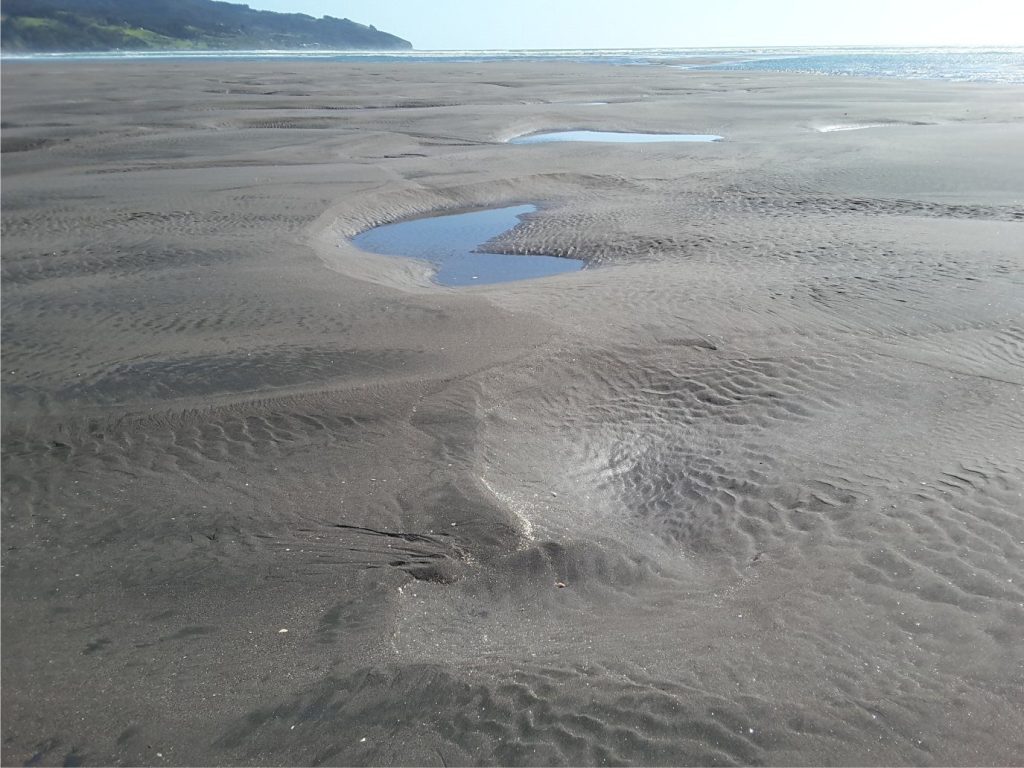
Use this link to read the introduction to the lithofacies series.
Ripples are ubiquitous bedforms in Earth bound and Martian environments! This post examines current-derived ripples and wave ripples.
(Asymmetric) ripple lithofacies
General occurrence:
Ripples are common sedimentary structures that form pretty well anywhere there is loose medium to fine-grained sand and air or water currents to move it (sand of any composition – carbonate, siliciclastic, evaporitic, volcaniclastic). You will find ripples on plateaus at rarefied elevations, at abyssal depths on ocean floors, and everywhere in between. And as a fascinating addendum to their ubiquity, they seem to be common bedforms in recent and ancient Martian sediments. They are so common they deserve a lithofacies category of their own.
External form:
Current ripples are characterised by asymmetric profiles with the lee slope facing down-flow. Amplitudes are typically less than 30 mm. They always occur in groups or ‘trains’ where the crest-to-crest separation, or wavelength ranges from 60-300 mm. In plan view, ripple crest outlines vary from relatively continuous straight or sinuous, to arcuate and discontinuous. For arcuate ripples, the troughs downstream of the lee face are commonly spoon-shaped.
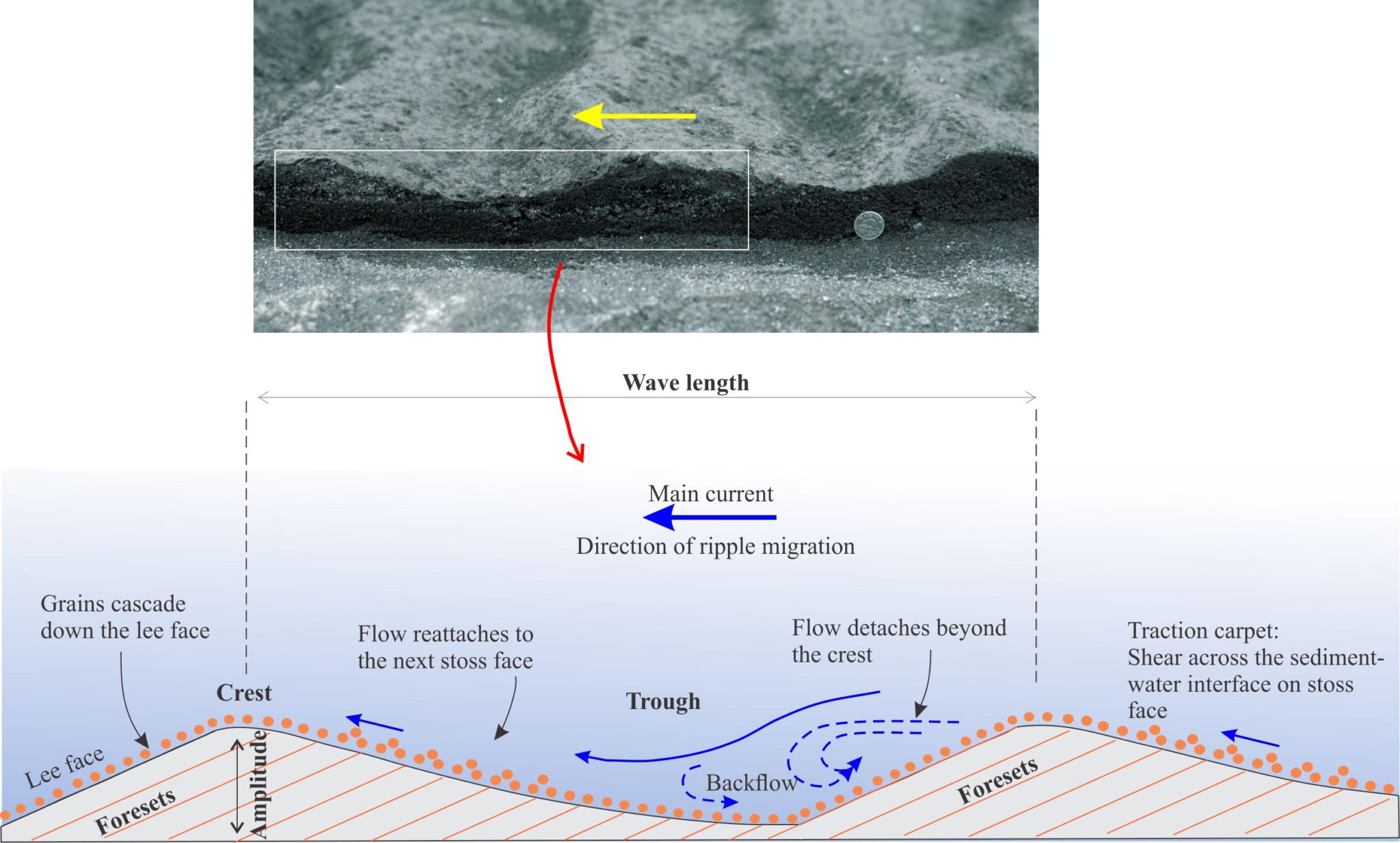
Inset: An idealised profile view of ripple morphology, crossbed foresets, and currents depicted as flow lines. Ripple migration to the left.
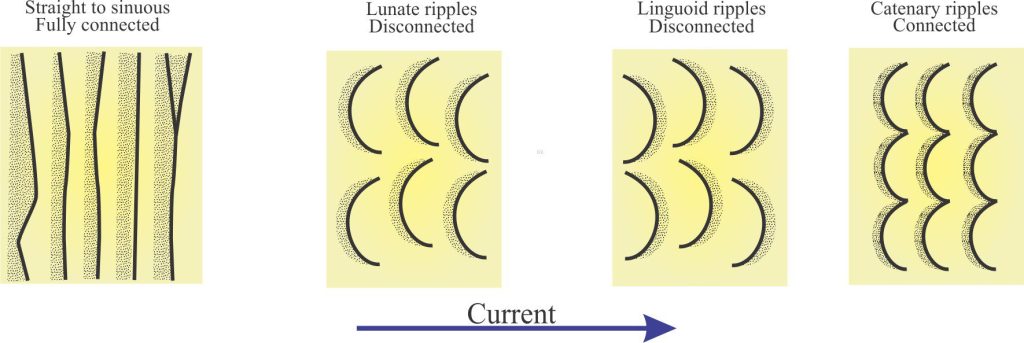
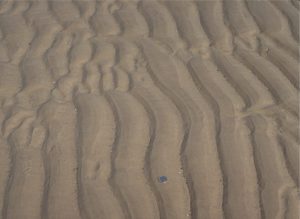
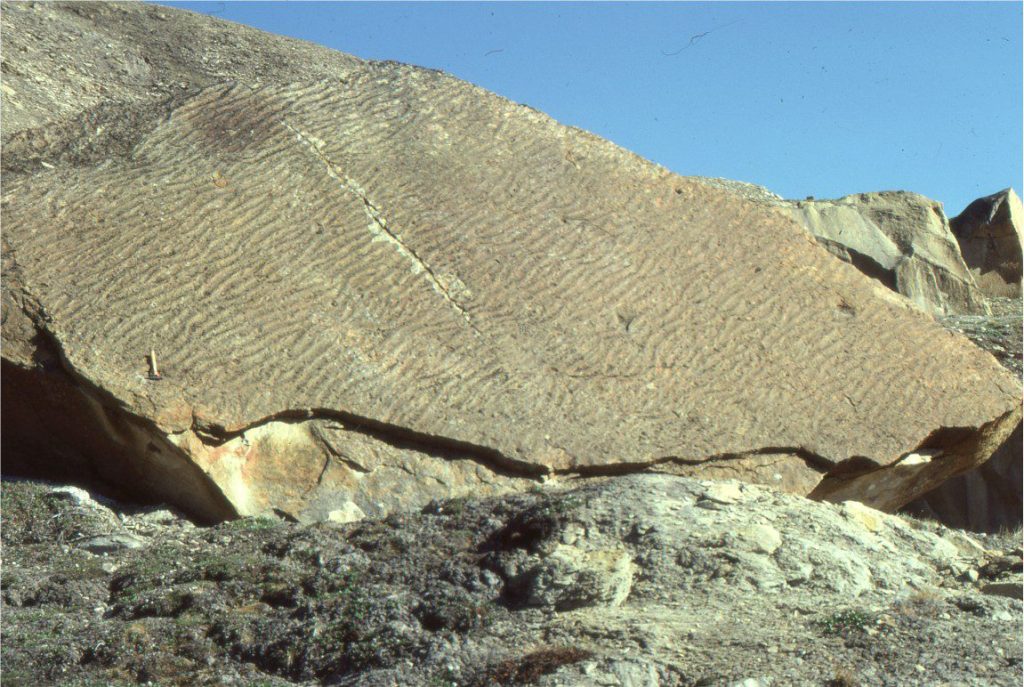
Arcuate crest forms include:
Lunate ripples – disconnected crests are concave in the downstream direction. Lower bounding surfaces may be spoon-shaped or scoured.
Linguoid ripples – disconnected crests are convex in the downstream direction. Lower bounding surfaces may be spoon-shaped or scoured. Scoured surfaces can develop in front of the lee face – some examples can be seen in the image below.
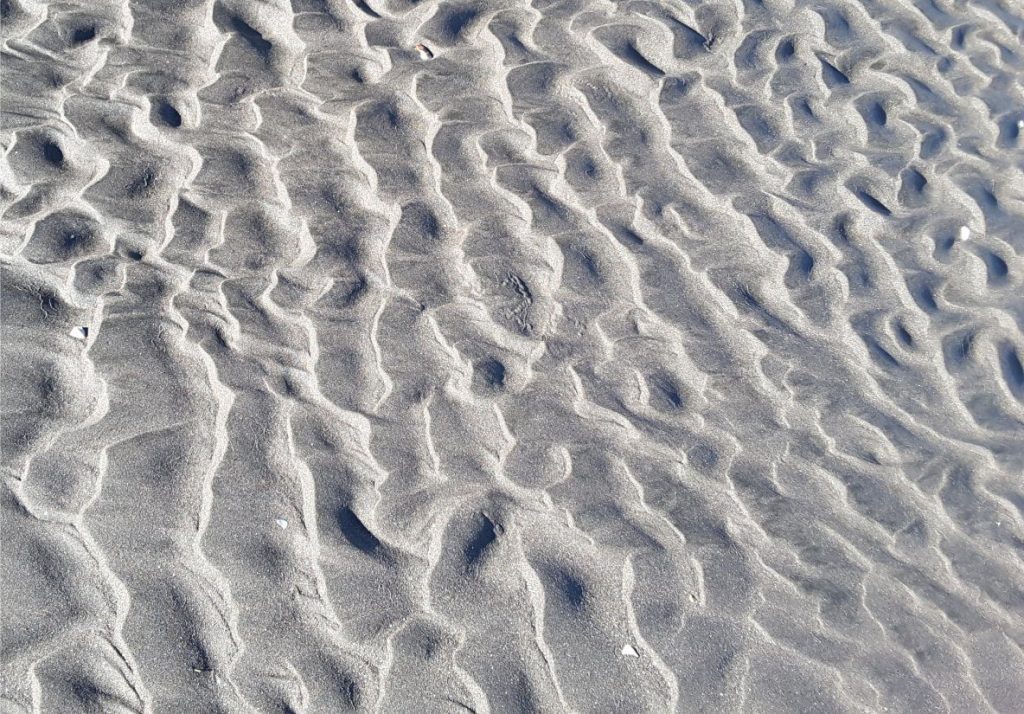
Catenary ripples – concave crests are connected in a more or less continuous line.
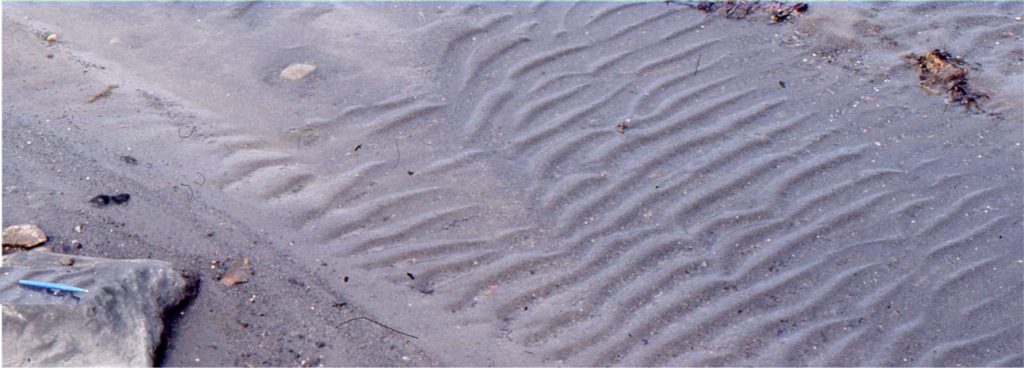
Straight-crested ripples are also referred to as 2D bedforms because a single profile at right angles to the crest trend will suffice to define the overall morphology and bounding surfaces. In contrast, lunate and linguoid ripples are 3-D bedforms where two profiles approximately at right angles are required to define the morphology and internal structure.
Internal structure:
Crossbed foresets, each one or two grains thick, are deposited on the lee face. Foresets are planar to concave (downflow). Foresets in linguoid and lunate ripples are commonly spoon-shaped, reflecting the geometry of their lower bounding surface. The lower bounding surface is planar in straight-crested ripples, and spoon-shaped in linguoid ripples; the upper surface will mimic the asymmetric ripple profile unless, as is usually the case, it is eroded by overlying bedforms.
Formation – hydraulic conditions:
Movement of fine- to medium-grained sand will begin once the flow velocity threshold is reached (and maintained – shown diagrammatically below). This threshold depends on grain density and grain shape. Sand is moved as a traction carpet and by saltation. In clear water conditions there is little or no contribution from suspended sediment. Ripple formation takes place at flow velocities greater than that required for lower flow regime plane bed. Under these conditions flow is subcritical (Froude number <1) and turbulent.
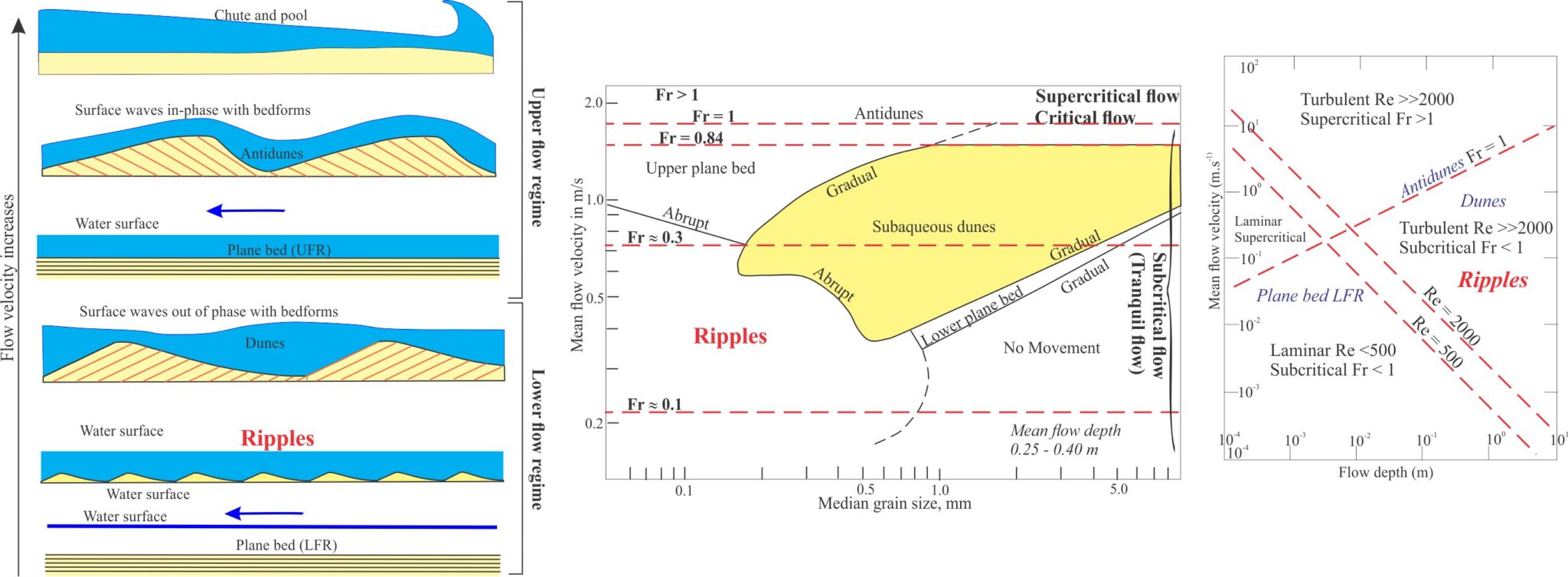
1- Flow Regime (left); after J.C. Harms & R.K. Fahnestock, 1965,
2- Median grain size and mean current velocities (centre); modified from Ashley, G.M. 1990,
3- Reynolds and Froude numbers as a function of flow depth and flow velocity (right); modified slightly from J.R.L. Allen,1992, Fig. 1.21.
Ripple fields are indicated in bold red type.
How ripples initiate is still something of a mystery although there is a consensus that bed roughness or minor prominences on the substrate play a role. For example, over a flat sand bed, current flow will tend to increase over the upstream side of a small obstacle (because of local pressure increases) and decrease on the downstream side. Minor perturbations in current velocities will initiate a series of eddies that further disrupt flow. Ripples may emerge from the sand bed if some kind of flow resonance develops.
Once formed, ripples migrate downstream. Under uniform current flow, sand grains are moved up the stoss face (jostling, rolling, bouncing) until they reach the ripple crest. At this point flow expands across the intervening trough and in the process loses its competency (i.e., its ability to move sediment). The sand grains tumble down the steeper lee face under the influence of gravity. Deposition on the lee face produces laminae that are one or two grains thick – these are the characteristic ripple crossbed foresets. Note that stoss face laminae are rarely preserved – exceptions include some climbing ripples and antidune bedforms.
Straight-crested ripples form under relatively uniform, sheet-like flow, for example across a tidal flat. Lunate and linguoid ripples form when relief on the depositional surface, like that created by larger bedforms, generates local variations in flow.
Symmetrical ripple lithofacies
General occurrence:
Also called wave ripples. They form above fair-weather wave-base in marine and lacustrine environments. They are prone to modification by bottom currents and changes in the wave climate (because of changes in wind patterns) and hence are less commonly preserved than asymmetric current ripples.
External form:
This class of ripple has symmetric profiles, where opposing ripple slopes have similar inclinations. Ripple amplitudes are similar to current formed ripples. Most are straight crested or bifurcating and oriented roughly parallel to shore. Their wavelength depends on wave periodicity and the size of the wave orbital.
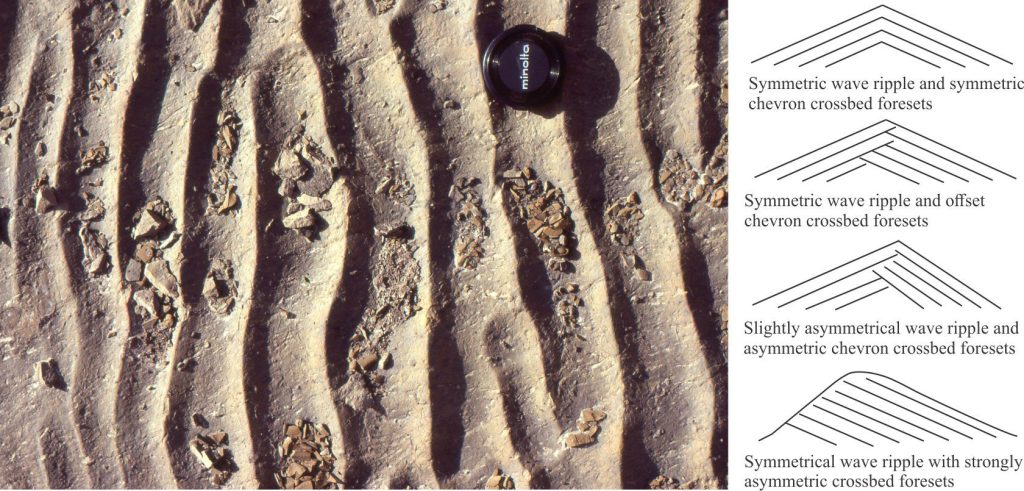
Internal structure:
Wave ripples are characterized by two sets of chevron-like crossbeds with opposing inclinations. The foreset dips may mimic the external ripple surfaces but can also be oblique to these surfaces. There can be some confusion and misidentification of wave ripples because they may present symmetric profiles but contain only one set of cross strata (as shown in the diagram above).
Formation – hydraulic conditions:
Symmetrical ripples form under conditions where flow oscillates. They are most common where periodic surface waves impact a sandy substrate. Under these conditions, the traction carpet moves to-and-fro as the wave orbitals pass overhead. In some situations, the forward and backward motions of wave orbitals may not be equal, and the resulting stratification may be similar to that produced by asymmetric current ripples but bound by a symmetric upper surface (like the example shown in the diagram above).
Watch this flume experiment of the effect of oscillatory flow on ripple morphology.
Common environments of deposition:
Sandy coastal shelves and platforms above wave-base, in marine and lacustrine settings where periodic surface waves are generated by wind shear. Their straight crests are aligned parallel to the surface waves and therefore, are approximately parallel to paleoshorelines. Ripple amplitude, wavelength and crest alignment may change depending on the variability of wind direction and strength. Ripples formed during fair weather may be washed out by storm surges. Wave ripples formed on tidal flats may be modified by ebb and flood tidal currents.
Other posts in the Lithofacies series
Sedimentary lithofacies – An introduction
Ripple lithofacies influenced by tides
Tabular and trough crossbedded lithofacies
Laminated sandstone lithofacies
Low-angle crossbedded sandstone
Hummocky and swaley cross-stratification
Lithofacies beyond supercritical antidunes
Subaqueous dunes influenced by tides
Introducing coarse-grained lithofacies
Other posts that provide useful background information on bedforms and processes include:
Crossbedding – some common terminology
Sediment transport: Bedload and suspension load


















1 thought on “Ripple lithofacies – ubiquitous bedforms”
beginner / self-taught and this is very helpful